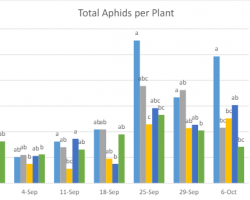Methods
Cabbage (‘Capture’) was seeded on June 7 and transplanted on July 8 at 18” in-row spacing in rows on 6’ centers. Treatment plots were 20’ in length and a randomized complete blocks design with 4 replications was used. Once the first aphids were observed, treatments were applied once a mean of ≥ 10 aphids/plant was reached using a pressurized backpack sprayer equipped with on hollow cone nozzle delivering 90 gallons per acre and operating at 60 psi. We counted aphids and mummies weekly and will collect marketable yield as well.
| Table 1. Reduction in number of aphids after spraying shows relative efficacy of products tested | |||
|---|---|---|---|
| 28-Aug | 4-Sep | ||
| Product | # Aphids | # Aphids | % Reduction |
| Untreated | 10.7 | 5.1 | 52.3 |
| Wrangler | 9.8 | 0.95 | 90.3 |
| Suffoil-X | 6.3 | 5.5 | 12.7 |
| M-Pede | 8.7 | 3.75 | 56.9 |
| Pyganic 5.0 | 13.3 | 5.3 | 60.0 |
| Azatin O | 8.1 | 5.6 | 31.1 |
| Grandevo WDG | 10.1 | 8.9 | 12.1 |
| Mycotrol O | 7.9 | 7.8 | 0.6 |
| PFR97 | 8.2 | 10.85 | -31.9 |
| Parasitism Rate (%) | 12.1 | 21.7 | |
Conclusions
Of the OMRI-approved insecticides tested the insecticidal soap M-Pede and the azadiractin-based product Azatin O significantly reduced the number of cabbage aphids per plant on three dates while other products did not significantly reduce CA numbers (see Figures 1 and 2 next page). Mixtures or rotations of these two products may be even more effective than either one used alone.

